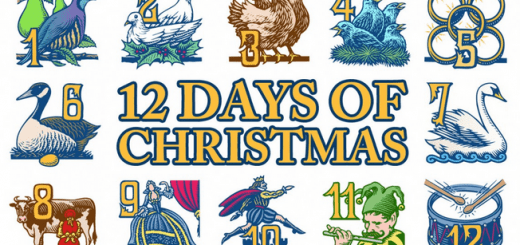Carol of the Bells
The instrumental of Carol of the Bells is derived from an early 20th century Ukrainian New Year Eve’s song by Mykola Leontovych (1877-1921) titled Shchedryk (tr. “Bountiful Evening”). Back in 1922, the Ukrainian National Chorus performed Shchedryk at Carnegie Hall, a popular concert venue found in the heart of New York City. It was through that performance that Peter Wilhousky (1902-1972), who was also from the Ukraine, picked up on the tune and decided to write completely-different, English lyrics to it, with his rendition becoming Carol of the Bells, which he eventually published and copyrighted in 1936.
Shchedryk itself is “based on traditional Ukrainian folk chants”, and Leontovych constructed it from four particular music notes he found while researching such songs. Said notes/chant, in their original incarnation, served as a celebration of Spring, which was recognized as the New Year in Ukraine way back in the days, before the people adopted Christianity (with the New year subsequently being moved to the second week of January). When Shchedryk was created, it was apparently on its way to becoming a hit in the Ukraine, and its hopeful message is theorized to be symbolic of the mentally of Ukrainians during their concurrent struggles against most notably foreign rule. And upon the country indeed being absorbed into the Soviet Union during the Ukrainian War of Independence, Shchedryk failed to maintain its popularity.
When Wilhousky decided to write his own lyrics to Shchedryk, he centered on a bell-oriented motif, because to him the melody of the song was reminiscent of hand bells. Peter created the piece to be performed by NBC Symphony Orchestra, whom he was also affiliated with. And to note, there are also other English versions of Carol of the Bells (i.e. with different lyrics) floating around out there, most notable in that regard a take written by one Minna Louise Hohman back in 1947.
Cover Versions
Being that this song is a popular Christmas carol, it has been covered by a number of notable musicians. That list includes the likes of Wynton Marsalis, who did so in 1990, Trans-Siberian Orchestra’s 1996 instrumental cover, which helped further the group’s notoriety, and Pentatonix dropping a rendition in 2013, which appeared on the Billboard US Holiday 100.
Carol of the Bells also made it onto Macaulay Culkin’s Home Alone (1990), one of the most-popular Christmas movies in American history. That version, as assembled by American arranger John Williams, recently found its way onto music charts, including the US Holiday 100 and UK Singles Chart, beginning in 2017. And the ever-lovable Muppets came out with a parody of Carol of the Bells in 2009 which was also well received, in that its associated video managed to go viral.
The Lyrics
Bells play an important role and recurring in the lyrics. Ringing bells specifically in the name of it being heard by people is a sound that automatically elicits an upbeat, alert or energetic response from us. And in this case, the bells are being rung in celebration of Christmas. Indeed, whereas it has been pointed out that bells did not exist back during Jesus’s day (or at least they didn’t in his region), in the modern world they are commonly used as a symbol associated with the holiday established in recognition of his birth. For instance, bell-oriented Christmas tree ornaments tend to be ubiquitous during the holiday season.
So going back to the lyrics, the vocalist goes about describing Christmastime bells as having a “joyful ring”, especially in terms of their association with caroling. So it would seem that in terms of the traditional practice of carolers actually going door-to-door and singing to their neighbors, such revelers would use bells to announce their arrival. And this would apparently be based on another practice, which is the ringing of bells, specifically those of the church variety, in recognition of the onset of the winter holiday season.
So this is one of the simpler Christmas carols out there, as it doesn’t really delve into Biblical ideology, the story of Jesus or anything of the such. Instead, what the vocalist is doing, most simply put, is rejoicing in the sound of Yuletide bells. And that’s because of what they symbolize, which is the universally-enjoyable Christmas season.








